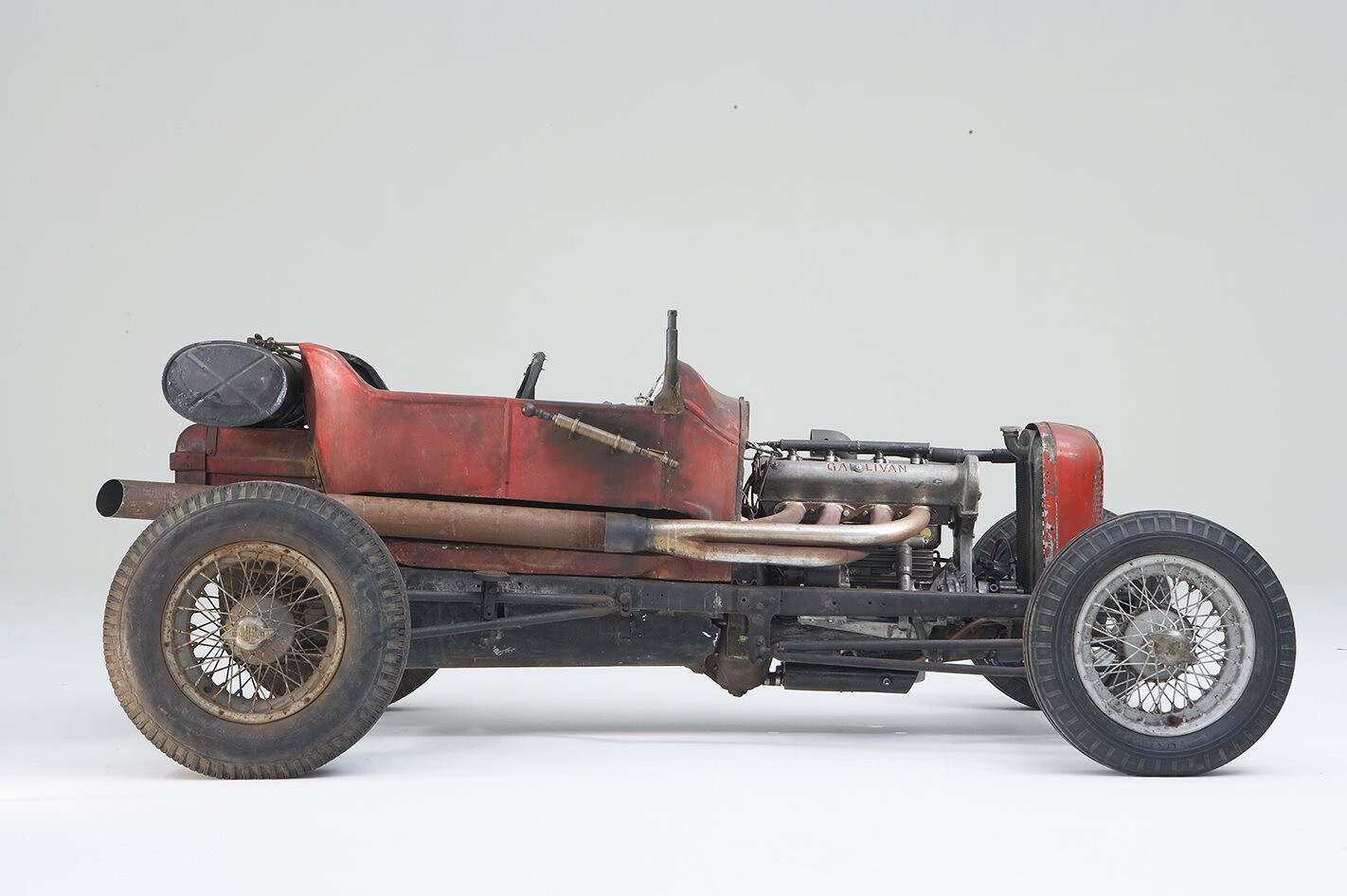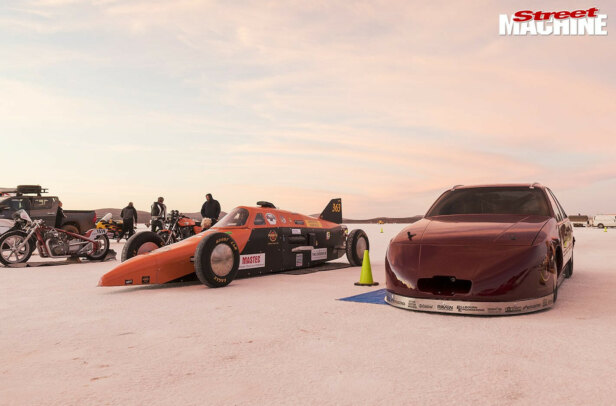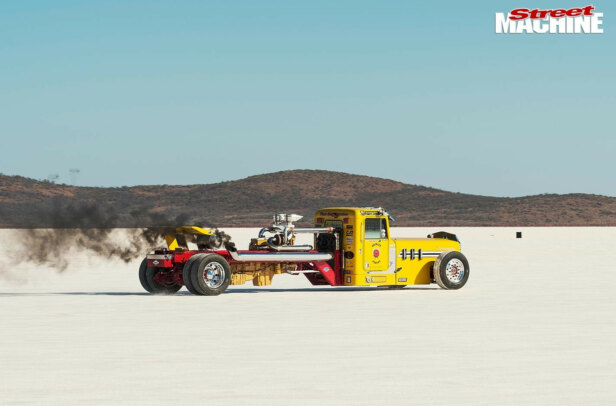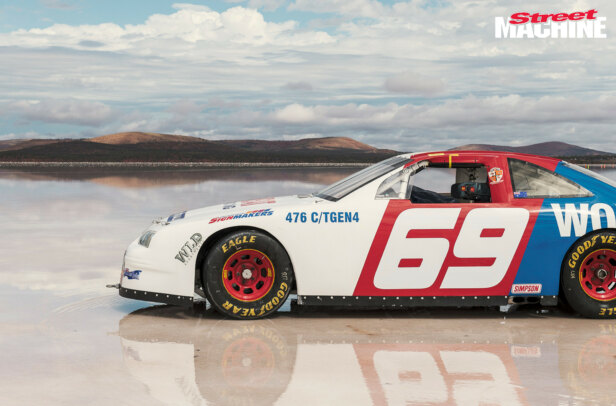TAKE a bunch of ultra-rare speedway parts, bolt them together in 101 days and you have the coolest lakester on the planet.
Imagine you’re in Southern California. It’s some time in the late 30s and you and your cousin Jim Bob have finally got hold of grandad’s old sprint car. You’re not interested in going around in circles like old pappy did; instead, you have your heart set on competing at the dry lakes and getting the car into the 100mph club.
That old monoposto (single-seat) body has to go because it doesn’t look hot rod enough — it really needs some old Ford body. Jim Bob remembers seeing an old ’23 T roadster down by the creek bed that would be perfect for the project. After dragging it home you discover that it’s a little bit too wide, so using the only tools you have — a few hacksaws and a gas welder — you section and narrow the body until it fits just right, and then you weld it back up.
The only thing left to do is to mount the fuel tank out back and fit the hand pump to build up some fuel pressure. It’s only taken a few days and, hey presto, a lakes modified that’s just itching to kick up some dust out at El Mirage.
Well, that’s what could have happened, but in reality that’s just one of many scenarios that the agile imagination of long-time hot rodder Colin Wade came up with during our conversation. The truth of the story is just as fascinating and riddled with historically significant cars, engines and people.
WHAT A DIFFERENCE A DAY MAKES
Back in 2005, Colin decided that he would build something to take to the Rat Rod Day — a Sydney event put on by Ray Flaherty and Nick Rees that favours hot rods and customs built to a certain level of unfinishedness.
Colin gave himself just 100 days to put together something that would blow everybody away. Unfortunately, he should have given himself 101 days. Colin made it to the event, but not until late afternoon when almost everyone (including myself) had gone home and, more importantly, the trophies had been handed out. Its next outing was the Nostalgia Drags at WSID and that’s where we first spotted it.
You may find it difficult to believe a car that so accurately represents its era could have been built in such a short time — just sourcing the parts would take years — and you’d be right to. Colin works as an antique dealer and makes many trips to the US, in his spare time scouring swap meets and doing deals with other collectors of old hot rod parts and speed equipment. “I’ve been collecting this stuff for more than 20 years, back to when it was still considered junk,” said Colin. “I’d walk past tables full of Stromberg 97s that were selling for five bucks each. Now a stuffed one costs $100!” Over the years Colin has collected a shed full of chassis, engines, speed equipment and even a few old race cars.
And that’s what he used as the basis for this old jalopy. Some 20 years ago Colin bought the old Lloyd Fisher #10 car from well-known US collector and racer Jim Lattin. The Fisher car had been raced from 1924 until the early 30s and used a modified Model T chassis as the basis.
It seemed a pretty good start for Project Rat Rod Day, so he started bolting things on it that he had lying around. Just the usual stuff — Model T axle, modified two-speed epicyclic box and a Ruxtell two-speed diff.
Wire wheels were the only way to go with this car, so Colin dragged out a set of Dayton wires; but not just any old set of wires. These are Dayton dental drive wheels, the absolute bee’s knees when it comes to wheels for early race cars. They’re wrapped in 5.50×16 Firestone Deluxe Champions up front and 7.00×16 Firestone Grooved Ascots out back.
It’s a perfect combination for this car and gives just a little of that must-have ‘rubber rake’. The interior is best described as spartan, like all good race cars, yet is well equipped. An original aircraft seat and harness keeps the driver in place as he stares through the cloth-wrapped Model T wheel towards the ’32 coupe dash.
Yes hot rodders, Colin chopped up a Deuce coupe dash to stop the gauges falling on the floor. Don’t complain though, he took it to dozens of swap meets and tried to sell it for $50, but no-one seemed very interested — it was too stuffed according to just about everyone who looked at it.
That, of course, made it perfect for the lakester. Colin narrowed it and cut a few holes in it to fit the set of gauges he had accumulated over the years. A mixed collection, comprising water temperature, oil pressure, fuel pressure and a 200mph Ford speedo fill the dash. A 200mph what? OK, Colin fudged it a little bit here.
The gauge is actually a ’36 Dodge unit — the newest part on the car by the way — and Colin modified the face so that it read to 200mph with a redline at 120mph. Wishful thinking? Well, maybe not. You see, the old banger powering the lakester is not some asthmatic old clunker that he’s just chucked in there to get it out of the way.
Although the collection of parts has been fairly impressive so far, and many of us would kill to have a similar stash in the shed, the engine really is something else. The block is an original ’26 Model T that has been given a new lease of life by Colin’s good mate and ace engine builder, Phil Jurd. Colin explained: “He took this old blown-up engine and fitted another block, crank, rods, full oil pressure system and put life back into this old museum piece. The engine is so reliable and makes plenty of grunt considering in its standard form it made only 20hp at 2200rpm.”
GALLIVAN’S TRAVELS
What makes it so special is the head conversion. Back in the 1920s there were literally dozens of people making aftermarket heads for the Ford four-cylinder powerplant. One of them was Jack E Gallivan of Rantoul, Illinois. Gallivan developed this gear-driven twin-overhead-cam engine back in 1926!
Featuring two-inch valves, cross-flow design and hemispherical combustion chambers, the Gallivan head was way ahead of the factory design and one of the most high-tech available at the time. It was also one of the most expensive, selling for $750, which would equate to just over $8000 in today’s money. Probably explains why only six were ever built. Yep, what you’re looking at is one of six and most likely the only one running on the street anywhere in the world.
Sales documentation shows that the engine could be fitted with one, two or four carbs or even a supercharger. Most engines ran the twin-carb updraught set-up, but the intake on this engine had already been modified to accept a single Winfield Model D. “The carby is so good that we didn’t have to touch it. It’s got a two-inch venturi with a barrel-type throttle and five adjustable jets on a spray bar. In the 20s it was state-of-the-art,” Colin told us.
The exhaust is even an original old sprint car piece from the 30s. Colin just added the four-inch pipe that runs to the back of the car. The grille and radiator are also similar vintage sprint car parts that once graced the front of a Pop Dreyer car.
But did it work? According to the record books, yes. It won many races and clocked speeds of 120mph. That may not sound very fast by today’s supersonic standards, but back then, if your four-banger could reach 100mph you were considered a dead-set legend. A cool 120 per hour must have seemed godlike in a car with such pedestrian origins.
Built as a challenge to a few of his friends, Colin is really happy with how it turned out and said the build was a lot of fun. In the mad (and eventually fruitless) rush to get the car done in time, Colin had a few friends help him out. “John Hayes, Arthur Pappas and Peter Jurd all worked day and night for the last couple of days before the Rat Rod Day, but we arrived late and missed it all anyway,” he recalled.
But Colin’s got a couple of other projects in mind. First is to build Something Else for the 2007 Rat Rod Day; the second, to build a salt racer, might take longer. Colin said: “Phil Jurd and I hope to put something together for a four-banger record.” If this only took 100 days, imagine what he’ll be able to build given a few years! One thing’s for sure, we can’t wait to see it.




Comments